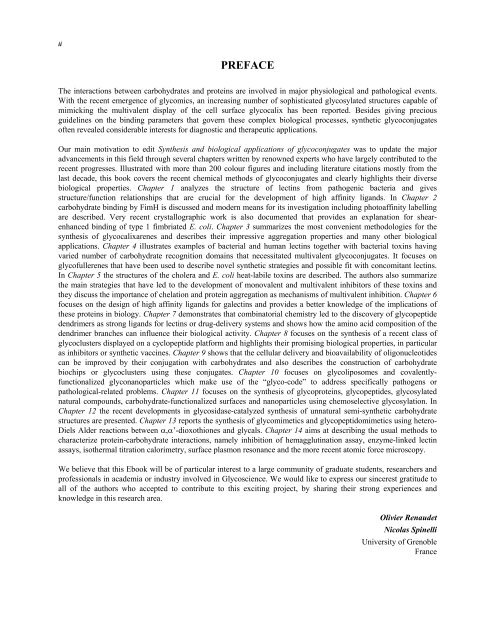chapter 2 - Bentham Science
chapter 2 - Bentham Science
chapter 2 - Bentham Science
You also want an ePaper? Increase the reach of your titles
YUMPU automatically turns print PDFs into web optimized ePapers that Google loves.
ii<br />
PREFACE<br />
The interactions between carbohydrates and proteins are involved in major physiological and pathological events.<br />
With the recent emergence of glycomics, an increasing number of sophisticated glycosylated structures capable of<br />
mimicking the multivalent display of the cell surface glycocalix has been reported. Besides giving precious<br />
guidelines on the binding parameters that govern these complex biological processes, synthetic glycoconjugates<br />
often revealed considerable interests for diagnostic and therapeutic applications.<br />
Our main motivation to edit Synthesis and biological applications of glycoconjugates was to update the major<br />
advancements in this field through several <strong>chapter</strong>s written by renowned experts who have largely contributed to the<br />
recent progresses. Illustrated with more than 200 colour figures and including literature citations mostly from the<br />
last decade, this book covers the recent chemical methods of glycoconjugates and clearly highlights their diverse<br />
biological properties. Chapter 1 analyzes the structure of lectins from pathogenic bacteria and gives<br />
structure/function relationships that are crucial for the development of high affinity ligands. In Chapter 2<br />
carbohydrate binding by FimH is discussed and modern means for its investigation including photoaffinity labelling<br />
are described. Very recent crystallographic work is also documented that provides an explanation for shearenhanced<br />
binding of type 1 fimbriated E. coli. Chapter 3 summarizes the most convenient methodologies for the<br />
synthesis of glycocalixarenes and describes their impressive aggregation properties and many other biological<br />
applications. Chapter 4 illustrates examples of bacterial and human lectins together with bacterial toxins having<br />
varied number of carbohydrate recognition domains that necessitated multivalent glycoconjugates. It focuses on<br />
glycofullerenes that have been used to describe novel synthetic strategies and possible fit with concomitant lectins.<br />
In Chapter 5 the structures of the cholera and E. coli heat-labile toxins are described. The authors also summarize<br />
the main strategies that have led to the development of monovalent and multivalent inhibitors of these toxins and<br />
they discuss the importance of chelation and protein aggregation as mechanisms of multivalent inhibition. Chapter 6<br />
focuses on the design of high affinity ligands for galectins and provides a better knowledge of the implications of<br />
these proteins in biology. Chapter 7 demonstrates that combinatorial chemistry led to the discovery of glycopeptide<br />
dendrimers as strong ligands for lectins or drug-delivery systems and shows how the amino acid composition of the<br />
dendrimer branches can influence their biological activity. Chapter 8 focuses on the synthesis of a recent class of<br />
glycoclusters displayed on a cyclopeptide platform and highlights their promising biological properties, in particular<br />
as inhibitors or synthetic vaccines. Chapter 9 shows that the cellular delivery and bioavailability of oligonucleotides<br />
can be improved by their conjugation with carbohydrates and also describes the construction of carbohydrate<br />
biochips or glycoclusters using these conjugates. Chapter 10 focuses on glycoliposomes and covalentlyfunctionalized<br />
glyconanoparticles which make use of the “glyco-code” to address specifically pathogens or<br />
pathological-related problems. Chapter 11 focuses on the synthesis of glycoproteins, glycopeptides, glycosylated<br />
natural compounds, carbohydrate-functionalized surfaces and nanoparticles using chemoselective glycosylation. In<br />
Chapter 12 the recent developments in glycosidase-catalyzed synthesis of unnatural semi-synthetic carbohydrate<br />
structures are presented. Chapter 13 reports the synthesis of glycomimetics and glycopeptidomimetics using hetero-<br />
Diels Alder reactions between ,’-dioxothiones and glycals. Chapter 14 aims at describing the usual methods to<br />
characterize protein-carbohydrate interactions, namely inhibition of hemagglutination assay, enzyme-linked lectin<br />
assays, isothermal titration calorimetry, surface plasmon resonance and the more recent atomic force microscopy.<br />
We believe that this Ebook will be of particular interest to a large community of graduate students, researchers and<br />
professionals in academia or industry involved in Glycoscience. We would like to express our sincerest gratitude to<br />
all of the authors who accepted to contribute to this exciting project, by sharing their strong experiences and<br />
knowledge in this research area.<br />
Olivier Renaudet<br />
Nicolas Spinelli<br />
University of Grenoble<br />
France

















